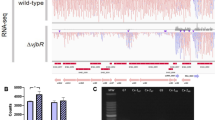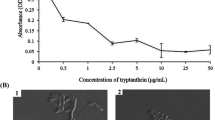Abstract
Genus Deinococcus is characterized by an increased resistance toward reactive oxygen species (ROS). The chromosome of five strains belonging to this genus has been sequenced and the presence of a luxS-like gene was deduced from their genome sequences. The aim of this study was to assess if a complete QS circuit is present in Deinococcus sp. and if this QS is associated with ROS. Primers for searching luxS-like gene and the putative receptor gene, namely ai2R, were designed. AI-2 signal production was evaluated by luminescence analysis using Vibrio harveyi BB170 as reporter strain. AI-2 signal was also evaluated by competitive assays using cinnamaldehyde, ascorbic acid, and 3-mercaptopropionic acid as interfering molecules. Potassium tellurite and metronidazole were used as oxidative stressors. A luxS-like gene as well as an ai2R gene was detected in strain UDEC-P1 by PCR. Cell-free supernatant of strain UDEC-P1 culture induced luminescence in V. harveyi BB170, and this property was inhibited with the three interfering molecules. The oxidative stressors metronidazole and potassium tellurite decreased Deinococcus sp. viability, but increased luminescence of the reporter strain. The results demonstrate that both a functional luxS-like gene and a putative receptor for AI-2 signal are present in Deinococcus sp. strain UDEC-P1. This finding also suggests that a complete QS circuit is present in this genus, which could be related to oxidative stress.






Similar content being viewed by others
References
Bassler BL (1999) How bacteria talk to each other: regulation of gene expression by quorum sensing. Curr Opin Microbiol 2:582–587
Baudet M, Ortet P, Gaillard JC, Fernandez B, Guérin P, Enjalbal C, Subra G, de Groot A, Barakat M, Dedieu A, Armengaud J (2010) Proteomics-based refinement of Deinococcus deserti genome annotation reveals an unwonted use of non-canonical translation initiation codons. Mol Cell Proteomics 9:415–426
Baumeister W, Kobler O (1978) Topographic study of the cell surface of Micrococcus radiodurans. Proc Natl Acad Sci USA 75:5525–5528
Čáp M, Váchová L, Palková Z (2012) Reactive oxygen species in the signaling and adaptation of multicellular microbial communities. Oxid Med Cell Longev 2012:1–13. doi:10.1155/2012/976753
Don RH, Cox PT, Wainwright BJ, Baker K, Mattick JS (1991) ‘Touchdown’ PCR to circumvent spurious priming during gene amplification. Nucleic Acids Res 19:4008
Dubey GP, Ben-Yehuda S (2011) Intercellular nanotubes mediate bacterial communication. Cell 144:590–600
Frias J, Olle E, Alsina M (2001) Periodontal pathogens produce quorum Sensing signal molecules. Infect Immun 69:3431
Guex N, Peitsch MC (1997) SWISS-MODEL and the Swiss-PdbViewer: an environment for comparative protein modeling. Electrophoresis 18:2714–2723
Herbert RA (1990) Methods for enumerating microorganism and determining biomass in natural environments. In: Grigorova R, Norris JR (eds) Methods Microbiol. Techniques in Microbial Ecology, vol 22. Academic Press, London, pp 1–40
Im W-T, Jung H-M, Ten L, Kim M-K, Bora N, Goodfellow M, Lim S, Jung J, Lee S-T (2008) Deinococcus aquaticus sp. nov., isolated from fresh water, and Deinococcus caeni sp. nov, isolated from activated sludge. Int J Syst Evol 154:2348–2353
Lambert C, Leonard N, De Bolle X, Depiereux E (2002) ESyPred3D: prediction of proteins 3D structures. Bioinformatics 18:1250–1256
Lee SH, Oe T, Blair I (2001) Vitamin C-induced decomposition of lipid hydroperoxides to endogenous genotoxins. Science 292:2083–2086
Lewis HA, Furlong EB, Laubert B, Eroshkina GA, Batiyenko Y, Adams JM, Bergseid MG, Marsh CD, Peat TS, Sanderson WE, Sauder JM, Buchanan SG (2001) A structural genomics approach to the study of quorum sensing: crystal structures of three LuxS orthologs. Structure 9:527–537
Mackenzie R, Barros J, Martínez M (2011) Characterization of aerobic heterotrophic bacteria in cold and nutrient-poor freshwater ecosystems. World J Microbiol Biotechnol 27:2499–2504
Martinelli D, Grossmann G, Séquin U, Brandl H, Bachofen R (2004) Effects of natural and chemically synthesized furanones on quorum sensing in Chromobacterium violaceum. BMC Microbiol 4:25
Mattson M (2004) Pathways towards and away from Alzheimer’s disease. Nature 430:631–639
McDougald D, Gong L, Srinivasan S, Hild E, Thompson L, Takayama K, Rice S, Kjelleberg S (2002) Defenses against oxidative stress during starvation in bacteria. Antonie Van Leeuwenhoek 81:3–13
Miller MB, Bassler BL (2001) Quorum sensing in bacteria. Annu Rev Microbiol 55:165–199
Müller M (1983) Mode of action of metronidazole on anaerobic bacteria and protozoa. Surgery 93(12):165–171
Niu C, Afre S, Gilbert ES (2006) Subinhibitory concentrations of cinnamaldehyde interferes with quorum sensing. Lett Appl Microbiol 43:489–494
Pearson R, Steigbigel R, Davis H, Chapman S (1980) Method for reliable determination of minimal lethal antibiotic concentrations. Antimicrob Agents Chemother 18:699–708
Pérez JM, Calderón IL, Arenas FA, Fuentes DE, Pradenas GA (2007) Bacterial toxicity of potassium tellurite: unveiling an ancient enigma. PLoS One 2(2):e211. doi:10.1371/journal.pone.0000211
Plummer P, Zhu J, Akiba M, Pei D, Zhang Q (2011) Identification of a key amino acid of LuxS involved in AI-2 production in Campylobacter jejuni. PLoS One 6(1):e15876. doi:10.1371/journal.pone.0015876
Rozen S, Skaletsky H (2000) Primer3 on the WWW for general users and for biologist programmers. Methods Mol Biol 132:365–386
Slade D, Radman M (2011) Oxidative stress resistance in Deinococcus radiodurans. Microbiol Mol Biol Rev 75(1):133–191
Sun J, Rolf D, Wagner-Döbler I, Zeng AP (2004) Is autoinducer-2 a universal signal for interspecies communication: a comparative genomic and phylogenetic analysis of the synthesis and signal transduction pathways. BMC Evol Biol 4:36
Tamura K, Peterson D, Peterson N, Stecher G, Nei M, Kumar S (2011) MEGA5: molecular evolutionary genetics analysis using maximum likelihood, evolutionary distance, and maximum parsimony methods. Mol Biol Evol 28:2731–2739
Tarpey MM, Wink DA, Grisham MB (2004) Methods for detection of reactive metabolites of oxygen and nitrogen: in vitro and in vivo considerations. Am J Physiol Regul Integr Comp Physiol 286:R431–R444
Vaal JM, Mechant K, Rill RL (1991) The influence of reducing agent and 1,10-phenanthroline concentration on DNA cleavage by phenanthroline + copper. Nucl Acids Res 19:3383–3388
Vilchez R, Lemme A, Thiel V, Schulz S, Sztajer H, Wagner-Döbler I (2007) Analysing traces of autoinducer-2 requires standardization of the Vibrio harveyi bioassay. Anal Bioanal Chem 387:489–496
Weisburg WG, Barns SM, Pelletier DA, Lane DJ (1991) 16S ribosomal DNA amplification for phylogenetic study. J Bacteriol 173:697–703
White O, Eisen JA, Heidelberg JF, Hickey EK, Peterson JD, Dodson RJ, Haft DH, Gwinn ML, Nelson WC, Richardson DL, Moffat KS, Qin H, Jiang L, Pamphile W, Crosby M, Shen M, Vamathevan JJ, Lam P, McDonald L, Utterback T, Zalewski C, Makarova KS, Aravind L, Daly MJ, Minton KW, Fleischmann RD, Ketchum KA, Nelson KE, Salzberg S, Smith HO, Venter JC, Fraser CM (1999) Genome sequence of the radioresistant bacterium Deinococcus radiodurans R1. Science 286:1571–1577
Acknowledgments
This work was supported by FONDECYT, Grant Nº 1100462. The Authors thank Miss Ruth Contreras for her technical support, and Mrs. Maria E. Larenas for her critical review of language proficiency.
Author information
Authors and Affiliations
Corresponding author
Rights and permissions
About this article
Cite this article
Fernandez-Bunster, G., Gonzalez, C., Barros, J. et al. Quorum Sensing Circuit and Reactive Oxygen Species Resistance in Deinococcus sp.. Curr Microbiol 65, 719–725 (2012). https://doi.org/10.1007/s00284-012-0225-1
Received:
Accepted:
Published:
Issue Date:
DOI: https://doi.org/10.1007/s00284-012-0225-1




